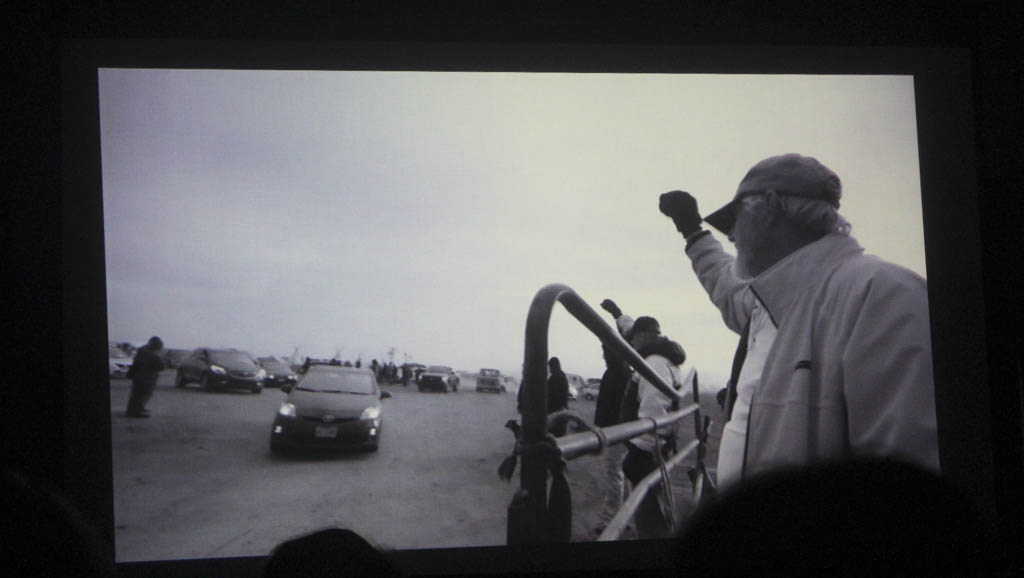EAST BRUNSWICK In an effort to examine ongoing cases involving Native American rights and sovereignty, the East Brunswick Library hosted a session with a co-producer of the documentary “Beyond Standing Rock.”
The film investigates the collision of energy development with Native Americans who live in the area. It shares three stories focusing on the Standing Rock Sioux and the Dakota Access Pipeline, the Southern Ute Tribe energy development, and a coalition of tribes in the Four Corners region, fighting for control of the Bears Ears National Monument, according to a statement provided by the library.
The library’s Adult Programming Librarian Melissa Hozik hosted the event on Sept. 7, saying, “The issues of energy consumption and Native American tribal rights have been very present in United States’ media for the past year. With all of the flurry of news in this day and age, it is extremely difficult to step back and evaluate both sides of every issue.”
After showing the documentary, the film’s co-producer Leigh Paterson joined the event via Skype to answer questions locals had about the issues highlighted in the film.
Today, Paterson works as a correspondent for Inside Energy and co-produced the film in three months. The film was released in February.
In the summer of 2016, one of Paterson’s colleagues based in Bismarck, North Dakota, heard about people camping near the Standing Rock Sioux reservation and discovered that there was a protest taking place, according to Paterson.
“Our reporting project started covering this issue extensively and what we found that in the day-to-day reporting was that there was so much going on. All the different protests and the dog attacks, and the different decisions on the federal level and [with] the protests getting bigger and bigger, there was so much daily news to cover that we weren’t really able to report on the context of the whole situation,” she said. “So, we decided to do this project really so that we could tell this story of the pipeline protest properly, which we weren’t able to do in our daily news coverage, so that was kind of the birth of the documentary.”
According to Paterson, the concept of sovereignty is what ties the three stories together regarding the Bears Ears National Monument in Utah, the Southern Ute tribe in Colorado and the Standing Rock Sioux in North Dakota.
“Sovereignty basically means that federally recognized Native American tribes are their own governments. They manage their own membership, manage their own businesses, [and] usually live on a reservation. Native American tribes are sovereigns; they are separate from states [and] they’re separate from the federal government. Sovereignty is important in the context of resource and land development because it means that tribes have leverage essentially over what is theirs,” Paterson said.
Starting the documentary off in North Dakota, the film first examined the controversy behind the building of the Dakota Access Pipeline. The pipeline is 1,200 miles long and will transport crude oil from North Dakota to Illinois.
In the fall of 2016, construction on the pipeline was almost complete with only a section near the Standing Rock Sioux reservation still needing approval from the federal government to be built.
For months, the Sioux tribe and its supporters protested the building of the pipeline and set up camps along the Missouri River. Since the pipeline would cross under the river, the tribe raised concerns that if the pipeline broke it would contaminate the water and damage a site they consider sacred.
The tribe was ignored and not properly consulted by the government regarding the building of pipeline prior to the start of construction, according to Standing Rock Sioux Tribe Chairman Dave Archambault II, who was interviewed in the film.
Back in Colorado, the film showed how the Southern Ute Tribe utilized the natural oil and gas that is located on their reservation to advance their economic status by creating their own oil and gas company and pipeline company.
“In the case of the Southern Ute tribe, they used their own sovereign status to assert greater control over the resources on their reservation and that came in the form of oil and gas drilling. … What the Southern Ute tribe did was they worked and lobbied for many years to get more control over that process, and that means getting a better royal rate on the oil and gas they were developing,” Paterson said.
Ending in Southeast Utah, the film documented the ongoing debate to keep the newly designated Bears Ears National Monument a monument. The conflict primarily lies between a group of Native American tribes called the Bears Ears Intertribal Coalition vs. local lawmakers.
The coalition wants collaborative control over managing the monument, due to the monument having ancient Native American petroglyphs and historical value. However, local lawmakers believe the land where the monument is located should be federally owned and asked President Donald Trump to overturn the monument’s designation.
“‘Beyond Standing Rock’ enabled viewers to see the story from the eyes of those directly involved. We learned about this documentary through the Cranbury Public Library, in the town where Leigh Paterson’s family resides. While we could not have Paterson in-person … we wanted patrons to be able to speak with someone directly involved in the project who could answer in-depth questions. The video conference service Skype enabled us to do so,” Hozik said.
The event was co-sponsored by the East Brunswick Human Relations Council.
For more information visit www.beyondstandingrock.org.
Contact Vashti Harris at [email protected].

